Project Log: Saturday, October 22, 2011
The small cabinet behind the stove required a few
additional installations before I could consider
installing the cabinet front. Since I thought this
particular cabinet might be good for spices, cooking
oil, and that sort of thing, I decided to insulate it,
so that heat from the dark hull wouldn't overheat the
locker.
As elsewhere, I installed a simple piece of 1/2" rigid
foam insulation, which I covered with a 1/4" cherry
plywood panel. I held the panel and insulation
behind it in place with some small cleats on the sides.
Next, I built a narrow shelf across the back of the
locker, located about halfway up the door opening.
I milled additional small cleats to secure the shelf;
the cleats, the same size as the cleats I used to secure
the back panel, were too small for screws, so I used
glue and stainless brads to secure them while the glue
cured.
The shelf was 3" wide, enough for spice containers and
small bottles, and after I secured the shelf in place I
installed a 1-1/2" tall fiddle (1" above the shelf, plus
1/2" to cover the plywood) across the outer edge to hold
the shelf's contents. I thought this was a good
place to use a piece of cherry that had a knot in the
lower edge, most of which got cut away, but it wasn't a
piece I'd use somewhere highly visible. |
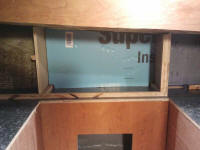
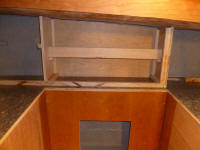
 |
Earlier, I'd drawn some locker openings on the cabinet
face behind the sink, but I'd not been happy with them.
I felt the key reference point on this section was the
centerline of the sink, where the faucet was located, so
I chose this point as that from which the remaining
measurements followed. Initially, I'd planned out
equal-sized openings on each side of this "center"
point, but because there was much more space on the aft
(right, as you look at it) side, it looked funny, and
the smaller opening on the after side also would limit
access to that part of the cabinet, which extended some
inches past. These marks are barely visible in
this photo. |
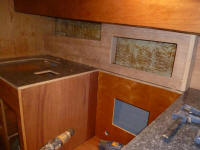 |
With all this in mind, I decided to extend the after
opening and end it the same distance from the aft end of
this cabinet section (in line with the plate shelf
opening) as the forward opening was from the adjacent
bulkhead, or 1-3/4". While the openings were no
longer equal, this arrangement just looked better to my
eye. I cut out the openings. Afterwards, I
applied a sealer coat of varnish to the back side of the
panel in preparation for its installation soon. |
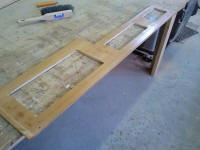 |
Normally, I'd not install something like the stove at
this early stage of the job, but now that it was in the
boat, and in the way, and wouldn't be leaving the boat
again, I wanted it in its designated spot once and for
all. The opening was more or less ready to accept
the stove, but there were a couple details remaining.
The back panel of the stove cutout would be inaccessible
with the stove in place, a bit less clearance than I'd
thought based on the measured drawings supplied with the
stove; the space I left was the correct size, but the
back part of the stove's housing extended a bit beyond
the top edge of the unit, where the measurements were
taken. This posed no particular problem, but it
did mean that I'd have to complete the propane hose and
other installations before I permanently installed the
stove.
I'd planned ahead for this, and now it was a simple
matter to install a little propane sniffer at the lower
back of the stove compartment, part of the propane
control system. I fully expected this sniffer to
fail and start giving false alarms--that seems to be
their main purpose in life--but I dutifully installed it
nonetheless. (It'd be easy to disconnect when it
started giving false alarms.)
The sniffer came with a 10' plug-in wiring harness, the
other end of which I'd connect to a propane control
panel nearby, and I ran the harness up to the wiring
chase as needed.
Similarly, I ran a length of propane hose from the
engine room, through the countertop, and into the
utility space behind the stove. Wherever the hose
passed through a bulkhead, or over any sort of wear
point, I passed it through short lengths of tough rubber
hose for chafing protection. I secured the hose as far
as the forward end of the engine room, then taped over
the open end and coiled the hose up for storage for now,
till I was ready to continue the run to the new propane
locker. |
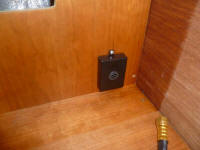
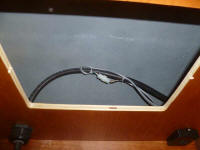
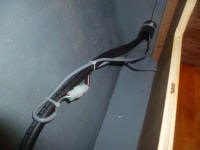

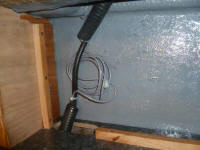
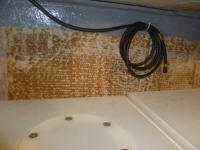 |
Where the hose exited into the stove cutout, I installed
a special vapor tight fitting--not necessary here, but I
chose the fitting because it was clean in appearance
(not that it was visible) and would secure and protect
the hose as well. I pulled through enough hose to
allow me to connect it to the stove when the unit was
just partially slid into the cutout. |
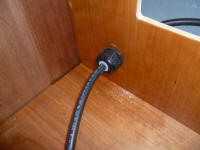 |
With my connections behind the stove complete, I
installed the cover panel over the opening, using a
couple knurled-head machine screws. Then, I
installed the upper panel over the galley cabinets,
securing it with glue and screws in pre-drilled holes,
which I then filled with cherry bungs. |
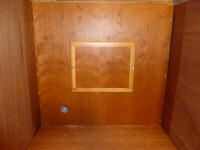
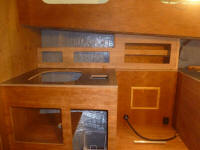 |
At this point, I was ready to install the stove.
Since I'd test-fit the stove, I thought this would be a
quick process, after which I'd move on to other things.
Instead, it turned into a two-hour odyssey.
To begin, I lifted the stove into its opening--being
careful not to let the sharp edge of the trim scrape and
scratch the Formica (which eventually happened
anyway)--and slid it back to its final position,
supposedly secured with the little bracket I'd installed
on the enclosure floor, and with the trim tight to the
face of the cabinet. After checking the position,
I marked the location of two screw holes at the forward
end of the range; these screws would secure the stove in
place.
I also noticed a problem: the trim piece I'd
installed at the front of the opening to cover the
plywood end grain was too wide, and parts of the stove
were hitting it, preventing the stove from resting
properly on the floor. I made notations where the
piece was hitting the stove so I could modify it as
needed. |
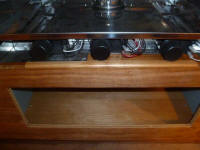 |
Removing the stove, I drilled holes at the marked
locations near the cabinet front. I planned to use
#10 machine screws and nuts, instead of the screws
suggested in the instructions. I also removed the
little trim piece, which was easy since I'd secured it
only with a pair of brads. I trimmed the trim down
to size--just 1/2" wide, to cover the plywood--and set
it aside to install later, once the stove was in place,
as I'd also determined this would be easier and
necessary.
Now, I returned the stove to the opening, pausing to
secure the propane line as needed before sliding the
stove into position. I could feel the stove slide
beneath the little bracket as intended, and then I got
it positioned where it needed to be side-to-side and
over the bolt holes. Easy. I secured the
bolts with fender washers and locking nuts from within
the locker beneath. |
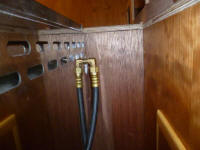
 |
The point of the bracket beneath the stove is so that
the stove cannot tip towards its front. With no
way to access the back or underside of the unit when in
place, someone obviously came up with this method,
perhaps as an afterthought, when designing the stove.
So with this in mind, I tested it: I pulled up on
the back of the stove, expecting firm resistance.
Instead, I found I could pull the stove up nearly 1/2"
at the back, this despite the bracket and the bolts at
the forward end. I was puzzled. I thought I
had the bracket in the right place, which I'd worked
carefully on during the test fit on an earlier work day.
However, I was willing to accept that the bracket might
need to move to better capture the stove, so I unbolted
the range, pulled it out, disconnected the LPG line, and
removed the stove from the opening.
I repositioned the bracket a bit further inboard; I knew
from an earlier positioning attempt that one set of
holes I had was too far out (and didn't let the range
slide all the way back till the trim was tight), and the
holes where I'd subsequently moved it were apparently
too far away, so I chose a spot in the middle and
resecured the bracket.
With this, I returned the stove to the opening, thinking
I'd surely worked out the glitch. Again, I secured
the hose, positioned the stove (once more, I felt it
slide beneath the bracket), and secured the bolts.
Smug in the belief that the stove was now well-secured,
I pulled up on the back of the stove, knowing it'd now
be tight and immobile; how could it not be, after all?
It wasn't. I could lift the back of the stove
nearly 1/2". |
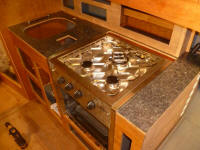 |
I couldn't figure out the problem. With a flashlight, I
could just see the bracket through one side of the front
of the stove, and the stove was clearly captured beneath
it. Awkwardly, I maintained my view of the bracket
and managed to pull the stove so I could watch what was
happening; the bracket captured the stove, all right,
but still allowed enough flex and movement, which
manifested itself in the lift I was able to achieve.
Completely unacceptable, yet it seemed to be how it was.
Disgusted, I removed the stove again--a relatively
simple process made onerous by the fact that the 2" long
bolts needed to be threaded most of the way in and out
thanks to the size of the holes in the sheet metal
bottom of the stove. Out on the settee, I mocked
up the hold-down bracket in its appropriate position at
the rear of the stove, as seen below. It was just
as I'd seen it through the small opening when the stove
was installed, and clearly there was simply too much
slop for the stove ever to be tightly held by the
bracket. |
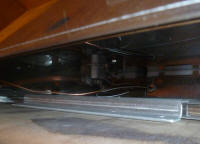 |
Getting a bracket of this nature to be tight enough,
while still allowing blind installation (i.e. not being
too tight), would seem to be a challenge--a
challenge not fulfilled by the designers, apparently.
For a few enraged moments, I ranted and raved with
derision to anyone who would listen about people who
design things, and how poorly so many things seem
adapted to the real world rather than these designers'
theoretical computer screens. Fortunately, no one
else was in the shop to hear; I was alone.
Clearly, the whole built-in trim kit, including the
useless bracket, was an afterthought, and obviously I
should have ordered the gimballed stove. But I
didn't, and they manufacture and sell the trim kit, and
I bought it and expected it to work. I was
extremely disappointed.
Regrouping, I made one more attempt to relocate the
bracket, this time to a set of holes that I knew was too
far out to let the stove trim seat tightly against the
cabinet, but I thought maybe it would force the bracket
into a tight fit. This time, I didn't install the
propane line. And the stove didn't fit, as I'd
expected, so I removed it and replaced the bracket to
the set of holes that I now knew unequivocally was the
best position for it.
I needed some way to hold the back of the stove down.
The bracket would ultimately hold it and prevent
catastrophic tipping, but any movement was unacceptable.
The stove needed to be tight and secure.
Eventually, I came up with a simple solution. At
the back end of the trim kit, the L-shaped trim left a
wide air space between the stove surround and the stove
itself (more of a gap than I'd wished for, in fact, but
this was no fault of the stove's--just my own).
But now this gap presented an opportunity: I could
install some wooden blocking at the rear of the
compartment, so the trim could slide over and rest upon
the wood, and then I could attach the trim directly to
the wooden blocking with screws.
If my opening had been slightly narrower (something--in
hindsight--I wish I'd done, but I went with the cutout
dimensions supplied with the trim kit), I could have
secured the trim directly to the countertop, perhaps,
but as it was there wasn't enough overlap to do so.
The blocking would give the bearing surface needed to
secure the trim with screws.
These screws, and the blocking, wouldn't be really
holding the stove per se, but would prevent the nuisance
movement I'd identified. In the worst event, the
bracket would hold the stove in place, but not without
this irritating movement. Preventing the movement
was what this was all about. This idea would also
cover the exposed plywood at the open back end of the
cabinet, which I'd planned to trim out anyway.
After determining the size of the stock I needed, I
milled two pieces, pulled the stove partway out, and
installed the blocking securely with screws to the
inside of the cabinet. Then, I slid the stove back
into position, tightly, and when I was sure everything
was in the right place I installed one pan head screw at
the back end of each trim piece. This held the
back of the stove securely against any movement. |
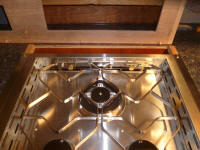

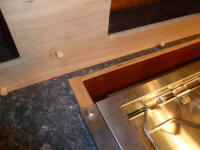 |
Later, I'd finish trimming out the back area and clean
up the blocking for better appearance, but I'd already
spent at least two hours (maybe three) on this install
that I thought might take 30 minutes tops, and the
afternoon had been wasted and was nearly over. I'd
diligently followed the instructions to the letter (or,
as it were, the number); yet I'd been let down.
All frustration aside, when all was said and done it
sure was a good-looking stove. I hoped the gimbal
installation arrangement, which most buyers would choose
(I wish I had), was better-conceived than the built-in.
I replaced the little trim piece at the front of the cabinet, holding it
with two screws since it would need to be removed
whenever (if) the stove had to be moved, and reinstalled
the oven door and trim. |
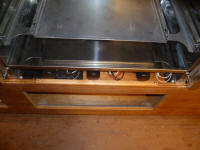
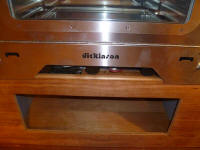 |
I'd hoped to do other things, but all I had time and
inclination for now, late in the day, was to pare away
the excess bungs from the new galley upper cabinet
front, after which I applied a sealer coat of varnish to
the face. |
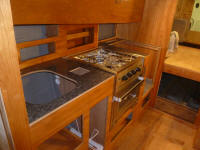
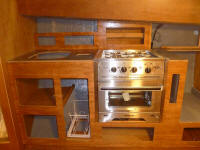
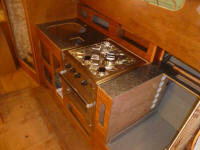 |
Earlier, I'd milled and varnished a fiddle for the shelf
beneath the sink, to close off the after end enough to
keep things from sliding off, and now I installed it
with glue and brads. |
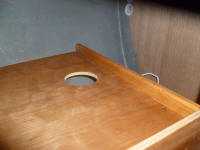
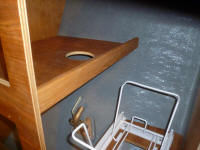 |
| |
Total Time Today: 7.25 hours
|
<
Previous |
Next > |
|
|






























